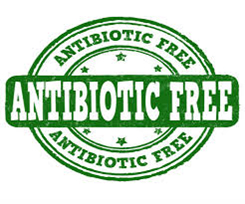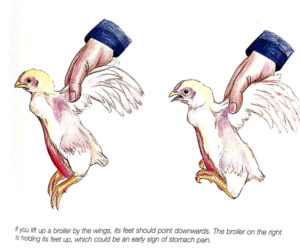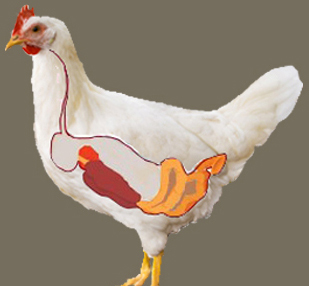There is no magic bullet for gut health. Whilst no single non-antibiotic product that is currently available on the market appears to be able to fully replace the functional effects of AGPs and can match similar gut health conditions. There are a variety of products that operate on similar axes and may form part of a multi-factorial displacement strategy for good gut health.

As per Law of diminishing returns, AGPs as well as alternative therapeutics or other agents will have improved functionality in populations of animals with poor performance and in diets with compromised nutritional value. Up late there has been so much of research on gut health benefits of enzymes. In this article, we will try to discuss on the same.
Exogenous enzymes and intestinal microbiome:
Inclusion of exogenous enzymes shift the site of digestion to anterior intestinal segments thereby ‘starving’ the microbiome of the posterior gut, producing fermentable oligosaccharides from previously largely inert fibrous material with a beneficial effect on intestinal pH and enterocyte proliferation. Also, use of enzymes improve the integrity of intestinal mucin, increase gastric residency of feed, reduced inflammatory responses and other beneficial effects on immune function and resilience.

Enzymes and enteric resilience:
Consideration of exogenous protease effects in reduction of undigested dietary and endogenous protein flow to the caudal gut, reduced inflammatory effects associated with proteinaceous antinutrients and improved gut tensile strength and tight junction integrity. Thus, exogenous enzymes may improve the stability of the gut by reducing substrate for putrefactive organisms, increasing substrate for beneficial fermentative organisms, and enhancing the ability of the intestine to defend itself against unwanted bacterial Colonization.
Use of enzymes stabilize endogenous losses:
Nonetheless, it is apparent that Xylanase, phytase and Protease influence both the digestibility of ingested nutrients and the secretion and loss of endogenous nutrients. Accurate partitioning of the value of feed enzymes between exogenously derived benefits and those of an endogenous persuasion is important to ensure additivity of nutrient release (or matrix) values. Exogenous enzymes may be effective agents in maintenance of gut health through promotion of a more stable mucin layer.
Role of enzymes in gastric emptying:
Xylanase addition to both a maize/wheat-based and a maize-based diet resulted in an increase in peptide YY (PYY) concentration in the serum of broilers. As PYY is one of the hormones responsible for gastric emptying it is possible that xylanase may influence passage rate of feed, or residence time in the gastric phase of digestion, possibly via the ileal brake mechanism. The ileal brake mechanism is a control system that detects increased fermentation in the hind gut via VFA production by the microflora and stimulation of the enterocytes. When xylanases are added to poultry diet they generate xylo-oligomers which are more readily fermented in the hind-gut than their source polymers, stimulating ileal-brake effects and PYY.
Enzymes alter bacterial fermentation:
Elevated caecal temperature was observed in birds fed xylanase of approximately 1.5 °C, effects that imply increased fermentative activity. Altered substrate flow to the hind gut may originate from increased nutrient removal from the intestine by the host and a change in fermentable substrate for the resident bacteria in the posterior gut.
Enzyme influences immune proteins:
The amino acid profile of acute phase and other immune proteins are also known. A challenge (pathological or environmental) that increases the need for protective measures such as acute phase proteins or mucin, will have a somewhat calculable influence on amino acid requirements and the ideal ratio between amino acids may change.
Enzyme Combination Suiting Best For Gut
Whilst some biomarkers for like mucin flow or digestibility in general do exist it may be necessary to use more low-tech approaches such as measurement of litter moisture, water intake, excreta characteristics (moisture, consistency, colour, pH), observation of animal behavior and so on. The more information is available on the relative health and performance of the population and diet characteristics the more bespoke the enzyme recommendation can become.

In the absence of such inputs then an enzyme solution should ideally be broad-spectrum but comprised of individual activities that are specifically monitored and guaranteed (thermotolerant, measurable and so on). Activities that have been shown to improve nutrition and health status include Xylanase, Glucanase, Arabinofuranosidase, Amylase, Protease, Phytase, Pectinase, Mannanase and Alpha-galactosidase.
It is likely that not all of these enzymes will be required but a reasonable admixture that covers a wide range of substrates is logically useful and will assist the animal to manage the intestinal environment and ensure stability. Use of Phytase, Xylanase and Protease is crucial in maintaining performance and reduction of variation among growing birds in Indian conditions providing support to gut health.
##
For references, questions and feedback write to , Bangalore. Email id is novellife.bangalore@gmail.com and contact no Landline +91 (0)80-41326221 Mob– +91 96113 37444)
 (This article is a work of Novel Life Consultant and is for public information purpose only. This has been written to share knowledge on poultry nutrition and is not a legal information or statement. Reference to any specific product or entity doesn’t constitute an endorsement or recommendation by the company. The views expressed by the writer are their own and their appearance does not imply an endorsement of them or any entity they represent.)
(This article is a work of Novel Life Consultant and is for public information purpose only. This has been written to share knowledge on poultry nutrition and is not a legal information or statement. Reference to any specific product or entity doesn’t constitute an endorsement or recommendation by the company. The views expressed by the writer are their own and their appearance does not imply an endorsement of them or any entity they represent.)






